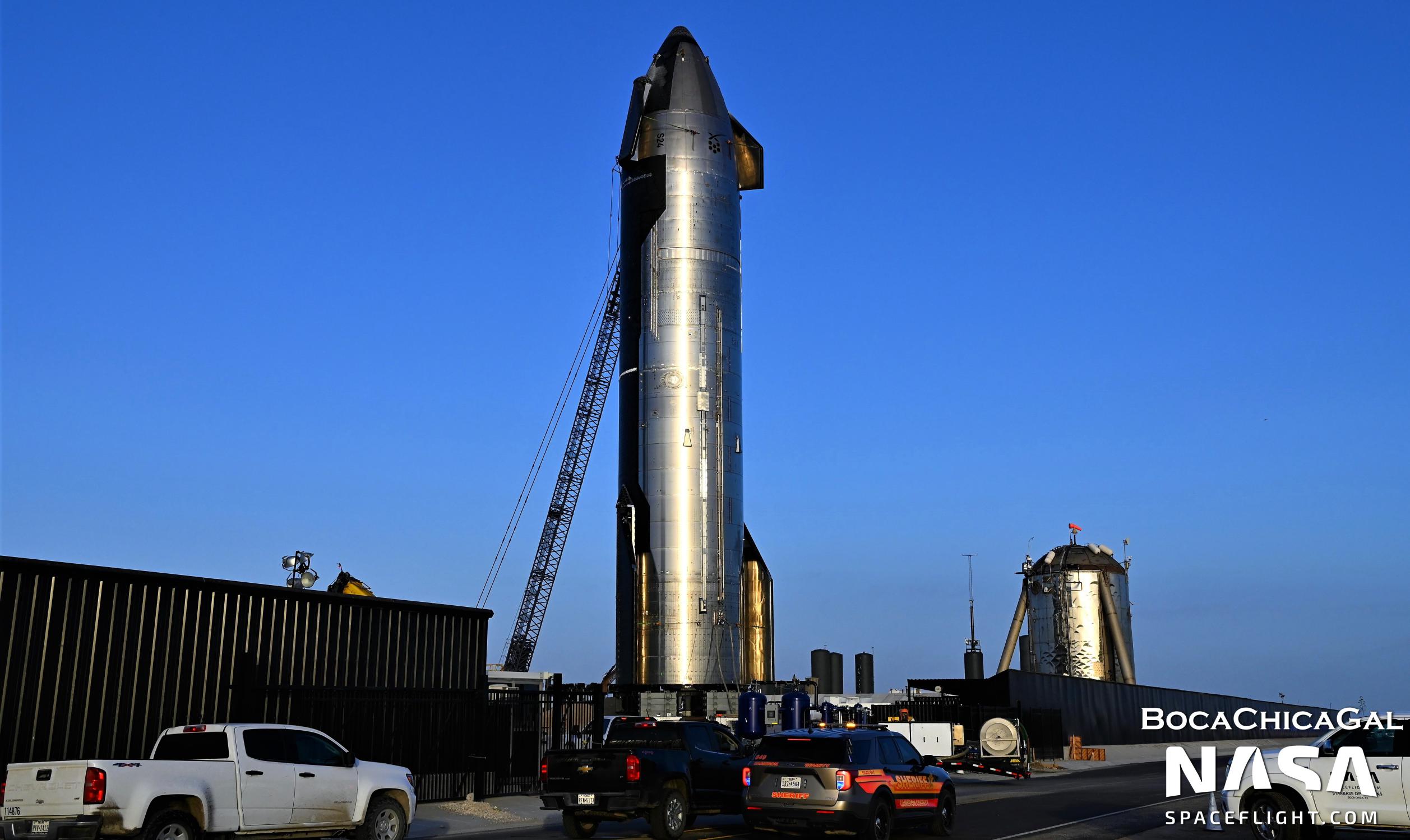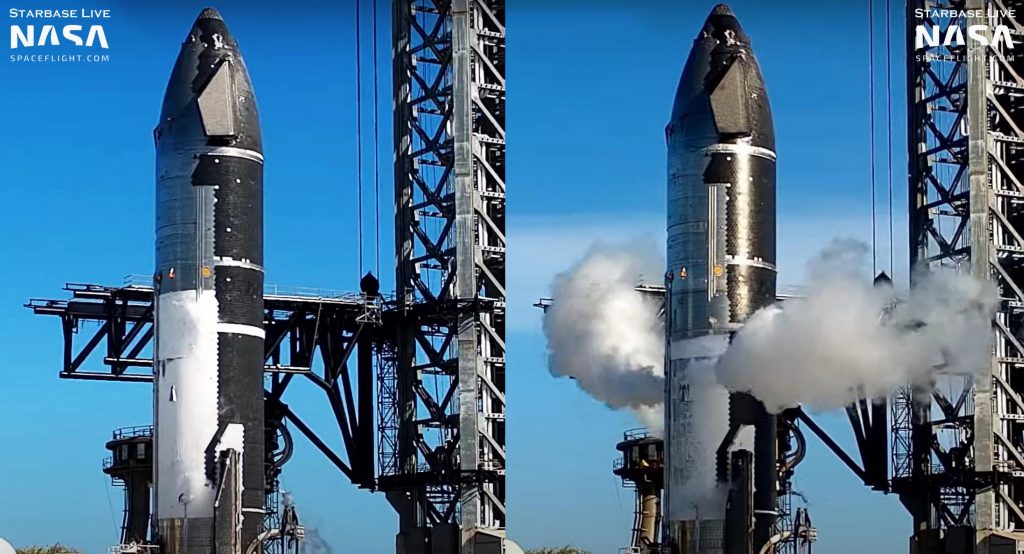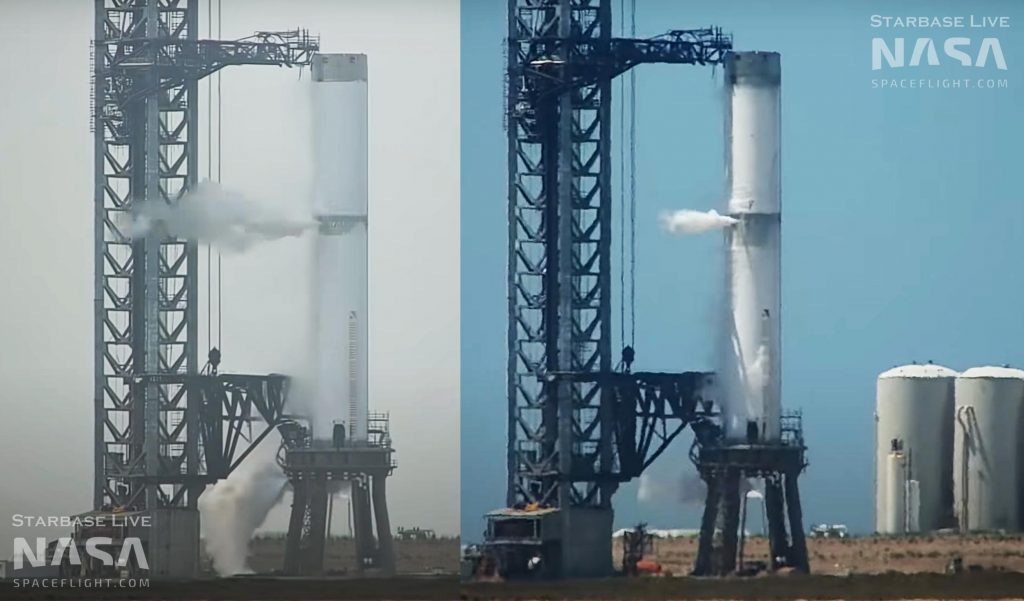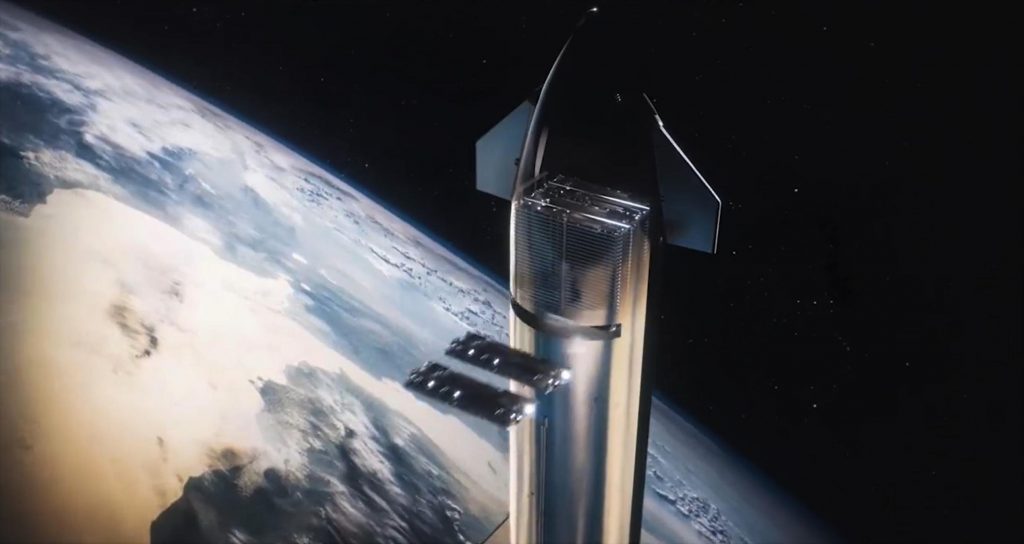

News
SpaceX sends Starship prototype to launch pad after engine installation
After several weeks of work back at SpaceX’s Starbase rocket factory, the company has transported a new and improved Starship prototype to nearby test and launch facilities, where it joined a similarly upgraded Super Heavy booster.
That Starship prototype – Ship 24 or S24 – is closely following in the footsteps of Super Heavy Booster 7 (B7), which kicked off a similar phase of preflight testing about two weeks ago. The purposes of their latest trips from the factory to the launch pad are also largely the same and could potentially open the door for Starship’s inaugural orbital launch attempt sometime later this year if the process goes smoothly. Both protypes have a ways to go, however.
Booster 7 and Ship 24 got off to fairly rocky starts when they began a less risky phase of proof testing in May and June. Apparently caused by improper sequencing or a small design flaw, a large steel tube meant to carry liquid methane fuel through Booster 7’s liquid oxygen tank and double as a storage vessel for landing propellant violently imploded when a vacuum formed inside it. It took SpaceX several weeks to repair the damage but, defying the odds, the tube was eventually repaired and Booster 7 completed another two proof tests soon after.
A few weeks later, during one of Ship 24’s first tests, a much smaller internal pipe – likely carrying high-pressure gas – also failed, damaging heat shield tiles and other adjacent plumbing. S24’s troubles were less dramatic and only took a few days to fix, but both were still new failure modes for the Starship program and served as a reminder that Starship hardware remains relatively immature and that SpaceX is still learning. Nonetheless, they also demonstrated SpaceX’s ability to respond quickly to new problems, as both B7 and S24 sailed through additional testing without apparent issue after quick repairs.


After completing cryogenic proof and thrust simulation testing, B7 and S24 returned to SpaceX’s factory facilities for Raptor installation and finishing touches. SpaceX took about six weeks to install 33 Raptor engines and associated heat shielding on Booster 7, while installing six Raptors and wrapping up a few other aspects of Ship 24 took about four weeks.

Aside from the installation of most of the Starship’s missing heat shield tiles, Ship 24’s preparations did include one particularly unique step involving its payload bay prototype. SpaceX’s first stab at a Starship payload bay has been likened to a giant Pez dispenser, which is not entirely inaccurate. Exclusive to Starlink, satellites will be stored on a rectangular rack that’s assumed to operate like an elevator. As an unknown mechanism pushes two satellites at a time through Starship’s slot-like bay door, the stack of satellites will feed downwards like bullets in a magazine until the full set is fully deployed.

In late June, SpaceX attached a giant white box to a crane and positioned the box to interface with Ship 24’s bay door, where it hung for the better part of a day. The test confirmed speculation that the box was meant to solve perhaps the most obvious problem SpaceX’s unique payload bay design posed: payload installation. SpaceX’s solution appears to involve using the deployment mechanism in reverse, with the white box conveying Starlink Gen2 satellites through the ‘slot’ and the dispenser grabbing and lifting each pair up into the bay.
It’s possible that Ship 24 will have a handful of Starlink V2/Gen2 satellites loaded into its bay if it passes its next tests. Before being cleared for flight, Ship 24 will need to complete at least one nominal wet dress rehearsal (simulating every aspect of a launch short of engine ignition) and one six-engine static fire, though several tests are far more likely. Starship S24’s test campaign will benefit significantly from Starship S20, which survived extensive testing (and multiple six-Raptor static fires) in 2021. In comparison, Super Heavy B7’s similar wet dress rehearsal and static fire test campaign will be almost entirely new to SpaceX, save for a single three-engine static fire completed by an outdated booster prototype last year.
SpaceX could attempt to static fire Booster 7 for the first time as early as Wednesday, July 6th. It’s unclear if the company will attempt to kick off Ship 24’s next round of testing in the gaps between Super Heavy B7’s static fire testing. While unlikely, SpaceX is technically capable of testing Ship 24 and Booster 7 simultaneously.
Elon Musk
Elon Musk confirms Grok 4 launch on July 9 with livestream event
The rollout will be accompanied by a livestream at 8 p.m. Pacific Time.

Elon Musk has officially confirmed that Grok 4, the latest version of xAI’s large language model, will launch on July 9. The rollout will be accompanied by a livestream at 8 p.m. Pacific Time, hosted on xAI’s official account on X.
xAI goes straight to Grok 4
Back in May, leaks indicated that xAI was getting ready to ship Grok 3.5. Considering Musk’s recent comments, however, it appears that the artificial intelligence startup would be focusing on the large language model’s fourth iteration instead. As noted in a Financial Express report, users on X have sighted references to Grok 4 in the lead up to the update’s launch, such as “grok-4-prod-mimic” and “Grok 4 Code.”
Musk’s Grok 4 announcement comes as AI competition intensifies between major players including OpenAI, Google, and xAI. With Musk’s Colossus supercomputer fully operational in Memphis, xAI appears to be accelerating its AI product roadmap.
Musk pushes Grok toward political neutrality
Grok 4’s launch also follows a recent controversy involving political bias, as noted in a CNN report. Last week, Grok responded to a user on X stating that political violence in the U.S. since 2016 had come more from the political right than the left. The chatbot noted in a later reply that its answer was based on information from sources like Reuters, the Journal of Democracy, and University of Maryland studies.
Musk stated that Grok’s response was a “major fail.” “Major fail, as this is objectively false. Grok is parroting legacy media. Working on it,” he wrote in a post on X. By the end of June, Musk noted that he was “grinding all night with the xAI team” and that they were making “good progress.” He also stated that the model “Will be called Grok 4. Release just after July 4th. Needs one more big run for a specialized coding model.”
News
Tesla opens massive solar Supercharger station in California
The Supercharger opened to customers ahead of Fourth of July weekend, while Tesla continues phase two of construction on the site.

Tesla has officially launched the first several Supercharging posts at a massive station in California, notably including solar canopies and grid-scale batteries to offer completely renewable charging.
Last week, Tesla announced on X that it opened the first 84 Supercharger stalls of a planned 168-stall station in Lost Hills, California. Additionally, the massive Supercharger project features 11MW of solar canopies and 10 Megapack batteries for off-grid charging powered entirely by solar energy.
Tesla completed the first phase of the project just days ahead of the busy Fourth of July holiday weekend, adding that initial construction took just eight months. In addition to the remaining charging stalls, Tesla says it’s building a set of lounge areas, renderings of which can be seen below alongside current photos of the site.
Notably, the site also includes V4 charging posts for the company’s latest available charging speeds, and it’s located near the busy junction between I-5 and Highway 46 in Kern County.
“Thank you [Kern County] and [PG&E] for collaboration and approvals,” Tesla wrote in a follow-up post.

Credit: Tesla Charging | X

Credit: Tesla Charging | X

Credit: Tesla Charging | X

Credit: Tesla Charging | X
Tesla Supercharger Maps for North America, Europe, and Asia pic.twitter.com/0U5r0XRPyo
— TESLARATI (@Teslarati) July 2, 2025
READ MORE ON TESLA SUPERCHARGERS: Tesla launches ultra-fast V4 Superchargers in China for the first time
Testing at the LA Diner, plus Musk update on potential Tesla solar Gigafactory
The huge Tesla Supercharger station completed phase one of construction fairly quickly, especially given how long Tesla has been working on its unique Los Angeles diner, drive-in, and Supercharger location. Still, the company was seen performing some testing at the nearly-completed charging station earlier this month, and will reportedly be holding a job fair.
Elon Musk also responded on Monday morning to a post on X, suggesting that Tesla is “thinking about” building a U.S.-based solar Gigafactory in order to help support increased power needs with AI growth, and to bolster domestic solar production.
Tesla is building a new UFO-inspired Supercharger in the heart of Alien country
News
Tesla driver walks away from major accident with minor injuries
The driver sustained only minor injuries, and the exact cause of the crash remains under investigation.

The driver of a Tesla Model Y survived and walked away from a harrowing accident on Monday in California, only sustaining minor injuries despite the vehicle being impaled by a guardrail.
On Monday morning around 4:34 a.m., the Los Banos division of the California Highway Patrol (CHP) responded to the accident on I-5 near Panoche Road, involving a 23-year-old in a Tesla Model Y. According to a post on social media, the driver veered off the road for unknown reasons in the northbound lane, before crashing directly into the guardrail and impaling the vehicle.
You can read the full message and photos from Los Banos CHP below, as were shared in a Facebook post on Monday afternoon.
This morning a Tesla model y was traveling in the #1 northbound lane of I-5 north of Panoche Rd. For unknown reasons driver allowed V-1 to veer off the roadway, travel through a dirt center divide, and crashed into the fixed metal guardrail. Lucky for the driver he only sustained minor injuries and was able to walk away. Driving a vehicle requires 100% attention to the road. Avoid distractions and focus on driving.

Credit: CHP Los Banos (via Facebook)

Credit: CHP Los Banos (via Facebook)

Credit: CHP Los Banos (via Facebook)
In a statement to SFGate, CHP officer Myles Anderson said that the driver only sustained minor injuries, while no arrests are made and drugs and alcohol are not suspected to have been involved. The report also notes that Tesla’s “cruise control and lane assistance features” were activated, according to Anderson. However, it’s not entirely clear if this is referring to Supervised Full Self-Driving (FSD), or to the cruise control and lane assist features baked into Autopilot.
At the time of writing, CHP has not yet responded to Teslarati’s request for clarification and additional details on the matter.
Tesla Crash Safety Ratings across its lineup: pic.twitter.com/ny30R7ceji
— TESLARATI (@Teslarati) July 1, 2025
READ MORE ON TESLA SAFETY: Tesla rolls out crucial new safety feature aimed at saving children
The news comes after Tesla has touted its vehicles as incredibly safe for many years. In December, for example, the company highlighted receiving top safety scores from regulators on four different continents throughout the world, including from the National Highway Traffic Safety Administration (NHTSA) and the Insurance Institute of Highway Safety (IIHS) in the U.S.
Tesla has also listed the goal of making its vehicles the safest on the road throughout the years, both in the overall design of its vehicles and in its Autopilot and Full Self-Driving (FSD) programs.
Tesla Model 3 ranks as the safest new car in Europe for 2025, per Euro NCAP tests
-

 Elon Musk1 week ago
Elon Musk1 week agoTesla investors will be shocked by Jim Cramer’s latest assessment
-

 News2 weeks ago
News2 weeks agoTesla Robotaxi’s biggest challenge seems to be this one thing
-

 News2 weeks ago
News2 weeks agoWatch the first true Tesla Robotaxi intervention by safety monitor
-

 Elon Musk1 week ago
Elon Musk1 week agoA Tesla just delivered itself to a customer autonomously, Elon Musk confirms
-

 News2 weeks ago
News2 weeks agoTesla Robotaxi rollout proves that Elon Musk still delivers, even if it’s late
-

 Elon Musk2 weeks ago
Elon Musk2 weeks agoxAI welcomes Memphis pollution results, environmental groups push back
-

 Elon Musk2 weeks ago
Elon Musk2 weeks agoElon Musk commends Tesla team on successful Robotaxi launch
-

 Elon Musk2 weeks ago
Elon Musk2 weeks agoElon Musk confirms Tesla Optimus V3 already uses Grok voice AI




















